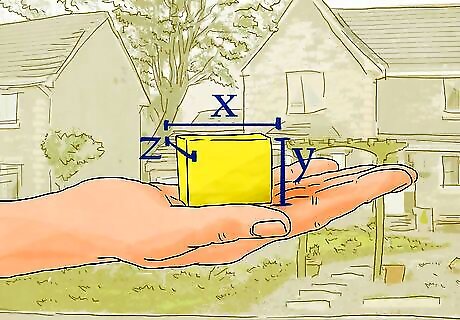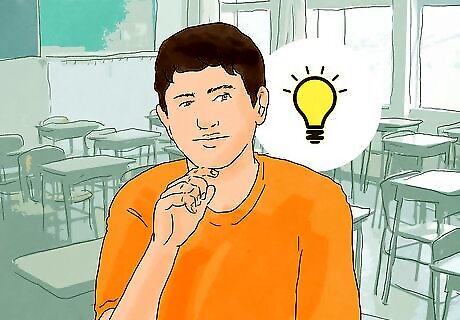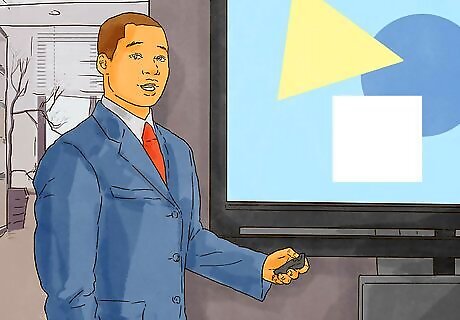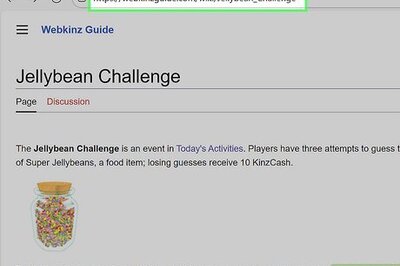
views
Helping Students Understand Math Concepts

Focus on teaching students why things work. Teaching math is like teaching a system of procedures. Whether you are teaching basic addition, long division, or integral calculus, you need to get your students to understand why the procedure works.

Look for understanding in student work. When students complete homework, quizzes or tests, you should examine their work to find out what they know. Don’t just look for the wrong answers, which show what they don’t know. Use the student’s knowledge base of right answers to set a base for additional work. Math is a sequential subject. Students who do not have a strong understanding base will have increased difficulty later.

Use memorization only as a tool. Some level of memorizing is still valuable in mathematics. Just as students learning a foreign language need to memorize basic vocabulary words, students learning math need to memorize certain basic facts. These are things that could be worked out or solved every time, but memorizing will allow the students to focus on more advanced understanding. Some examples, in increasing level of complexity, include: Addition, subtraction, multiplication and division facts Squares and square roots Powers of 2 and 10 Quadratic formula Trigonometric substitutions

Create opportunities for students to explore and develop rules. Rather than simply lecturing and giving students rules and definitions, give them projects that can help them discover math facts for themselves. Students will remember rules or relationships much better if they find them through self-discovery. For example, young students can be given fraction bars or other manipulatives. Through directed exploration, students can find certain patterns or equalities, like: 1 = 1 2 + 1 2 = 1 3 + 1 3 + 1 3 {\displaystyle 1={\frac {1}{2}}+{\frac {1}{2}}={\frac {1}{3}}+{\frac {1}{3}}+{\frac {1}{3}}} 1={\frac {1}{2}}+{\frac {1}{2}}={\frac {1}{3}}+{\frac {1}{3}}+{\frac {1}{3}} 1 4 + 1 4 = 1 2 {\displaystyle {\frac {1}{4}}+{\frac {1}{4}}={\frac {1}{2}}} {\frac {1}{4}}+{\frac {1}{4}}={\frac {1}{2}} Older students studying geometry, for example, can use tape measures and rulers to measure round objects and discover the relationships between circumference, diameter and radius: d = 2 r {\displaystyle d=2r} d=2r C / d = p i {\displaystyle C/d=pi} C/d=pi
Encouraging Practice

Allow class time for guided practice. After introducing a concept to the class, you should allow some time for each student to practice. This practice may be done alone as individual work, or you might set up students in working pairs or groups. As students work in class, you can move among them to check their progress. Allow them the opportunity to struggle a bit. When you see that students are having real difficulty grasping a topic, then you can step in and redirect them. EXPERT TIP Joseph Meyer Joseph Meyer Math Teacher Joseph Meyer is a High School Math Teacher based in Pittsburgh, Pennsylvania. He is an educator at City Charter High School, where he has been teaching for over 7 years. Joseph is also the founder of Sandbox Math, an online learning community dedicated to helping students succeed in Algebra. His site is set apart by its focus on fostering genuine comprehension through step-by-step understanding (instead of just getting the correct final answer), enabling learners to identify and overcome misunderstandings and confidently take on any test they face. He received his MA in Physics from Case Western Reserve University and his BA in Physics from Baldwin Wallace University. Joseph Meyer Joseph Meyer Math Teacher Tailor teaching math to each student's strengths. Facilitate collaborative mental math exercises that build on a student's existing skills. There are many paths to math mastery. By recognizing how each student sees numbers, you can tailor your teaching to their unique strengths and unlock their math abilities.

Use homework effectively. Students can learn new material during class time, but then you should assign homework problems to emphasize that learning. The homework should repeat the material learned in class and give students the chance to practice what they learned. You should give homework problems that are challenging enough to stretch all students but not so difficult that anyone will give up.

Avoid assigning excessive busy work. Students need to be engaged in the homework they do. If they begin to believe that homework is not valuable, they will not learn as effectively from it. Using a few key problems to emphasize a point and understand students’ learning will be more effective than many repetitive exercises. Individualize the homework. Gauge students’ level of understanding and assign homework for the students who most need the practice.

Review homework effectively. Students should expect that their homework will “count.” They should also see that you value their results. An effective use of homework is to start each class period with a quick group review. You can ask students to provide their answers, either orally or on the chalkboard and then solicit feedback from other students. This provides you, as the teacher, with immediate feedback as to which students understand the concept and which are still having difficulty. At the same time, the students will see immediately that completing their homework assignments has an effect on their classwork.
Using Technology

Use appropriate technology for teaching. Students are going to follow your lectures more if they see you using certain technological tools. You should become aware of what materials your classroom provides and be able to use them correctly. Some of these may include: Smartboards Computer projectors Programmed slide shows (PowerPoint, etc.) EXPERT TIP Joseph Meyer Joseph Meyer Math Teacher Joseph Meyer is a High School Math Teacher based in Pittsburgh, Pennsylvania. He is an educator at City Charter High School, where he has been teaching for over 7 years. Joseph is also the founder of Sandbox Math, an online learning community dedicated to helping students succeed in Algebra. His site is set apart by its focus on fostering genuine comprehension through step-by-step understanding (instead of just getting the correct final answer), enabling learners to identify and overcome misunderstandings and confidently take on any test they face. He received his MA in Physics from Case Western Reserve University and his BA in Physics from Baldwin Wallace University. Joseph Meyer Joseph Meyer Math Teacher Combine traditional methods with online tools to teach math. Traditional methods like manipulatives provide a strong foundation for younger students. As they progress, well-designed online tools can offer engaging visualizations and promote problem-solving skills, complementing, not replacing, traditional methods.

Allow students to use appropriate tools. Students are surrounded by technology, and they should be encouraged to use the tools that are available to them. In teaching math, you need to combine adequate memorization and understanding along with the use of technology. Students should be taught to use such tools as: Graphing calculators Smartboards iPads and other tablet accessories

Use apps or smart phones for homework. Students who habitually forget to write down homework assignments or who lose or forget their notebooks can be encouraged to enter assignments into their cell phone calendars. This is more likely to assure that the assignment at least makes its way home. You can also encourage your students to do their homework if you allow the use of certain support apps. Research the Internet for a wide variety of math homework apps that you might recommend to your students. Homework apps, if used improperly, can cut into student learning. But if you research the apps carefully and direct your students’ work, you can make the most of the available tools. MetaCalculator and WolframAlpha are two useful apps you may want to investigate.

Emphasize that technology is a tool to assist learning. Particularly in teaching math, you need to ask if the apps are adding to the learning experience or taking away from it. There are some apps, such as one called Photomath, that will actually show students the answers to their homework problems. While this could look like cheating, you need to require that students be able to explain their answers and the steps they perform. In this way, students who need help at home can use the app for guidance. In the end, however, they should know that you will be checking for their overall understanding.
Working with Students as Individuals

Find ways to challenge upper level students. Gifted students learn faster and more thoroughly than many of their classmates. They also find interest in different topics than other students. As a math teacher with gifted students, you need to find ways to challenge them and hold their interest. Some suggestions may include: Provide differentiated instruction, with separate textbooks. Give advanced students extra challenge projects to work on. Allow more opportunity for inquiry-based learning for students to explore mathematical relationships. Let students explore higher levels of math technology.

Provide extra support for slower students. Because math is a subject that continues to build on prior learning, it is important that you take extra efforts to make sure they understand before you move on. There are some special techniques you can use that will help slower students: Allow extra time. There is no requirement that every student must complete assignments in the same amount of time. Your emphasis should be on the learning, not on timing. Help students organize notes. Provide graphic organizers or outlines for their note taking. Pull them out in small teaching or discussion groups. Small groups are less intimidating and encourage all students to participate more. Provide tutors. You may be able to work with the students, their parents and guidance counselors to encourage outside tutoring. In some schools, honor society students may even do this for free as a community service to the school. Focus on concrete, real examples. Lower level students often think in more concrete terms. They may have difficult with some abstract concepts in algebra but do well with the real shapes of geometry.

Take a personal interest in all students. Students tend to perform best for the teachers they connect with most. Try to show an interest in your students that reaches beyond the classroom and the brief time you see them. Ask about their other subjects. If possible, show an interest in their extracurricular activities as well. For example, if you find out that a student enjoys playing basketball, you may then introduce ratios in terms of number of points scored per quarter.

Contact parents regularly. All students need to know that you and their parents share an interest in their development. For any problem students, you should contact the parents early, as soon as you see any difficult behavior starting to appear. You should also notify parents as much as possible when you have good news to share. The parents will appreciate your involvement and caring, and you will generally find that they will support your work to a higher level.


















Comments
0 comment